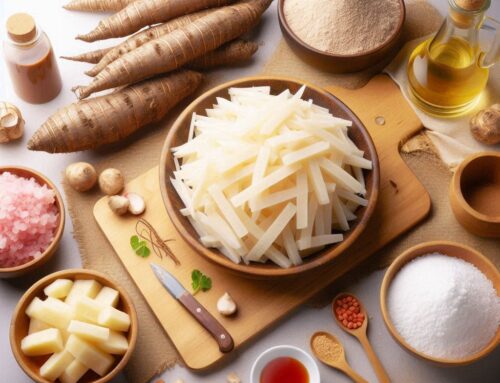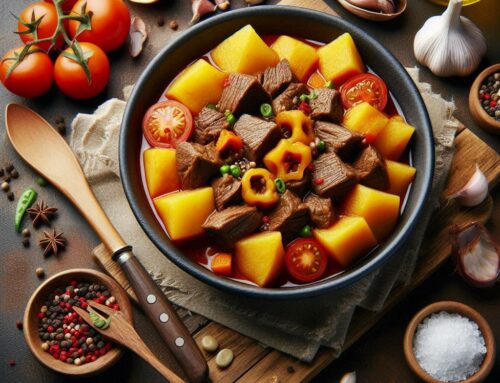
Introduction to Tapioca: Understanding Cassava and Its Culinary Uses
Tapioca, a versatile and popular ingredient, is derived from the cassava plant, a root vegetable native to South America but now cultivated in many tropical regions worldwide. Understanding what tapioca is begins with recognizing its source: the cassava root. This starchy tuber is processed to extract tapioca starch, which can be transformed into various forms such as pearls, flakes, or flour.
Cassava’s uses extend beyond just producing tapioca. The root itself can be boiled, fried, or mashed and used in numerous traditional dishes across different cultures. However, it’s the transformation into tapioca that has garnered widespread culinary interest due to its unique texture and adaptability.
One of the significant benefits of tapioca is its gluten-free nature, making it an excellent alternative for those with gluten sensitivities or celiac disease. This characteristic has led to an increase in gluten-free recipes incorporating tapioca flour as a substitute for wheat-based flours in baking and cooking.
Whether you’re looking to thicken soups and sauces or create delightful desserts like pudding or bubble tea pearls, tapioca offers a wide range of culinary possibilities while accommodating dietary restrictions. Its mild flavor allows it to blend seamlessly into both sweet and savory dishes, making it an invaluable ingredient in modern kitchens around the globe.
The Nutritional Benefits of Including Tapioca in Your Diet
Tapioca, derived from the cassava root, is a versatile ingredient that offers several nutritional benefits, making it a valuable addition to your diet. One of the most significant advantages of tapioca is its status as a gluten-free alternative, which makes it an excellent choice for individuals with celiac disease or gluten sensitivities. This starchy substance provides a good source of carbohydrates and energy without any gluten-related complications.
The nutritional value of tapioca primarily lies in its carbohydrate content, which can serve as an effective energy booster. While it is low in protein and fat, it can be paired with other nutrient-rich foods to create balanced meals. Tapioca is also known for being easy to digest, making it suitable for people with digestive issues.
Another aspect worth noting is the cassava health benefits associated with tapioca consumption. Cassava roots are rich in essential nutrients such as calcium and iron, contributing to bone health and preventing anemia. Additionally, tapioca contains small amounts of fiber that can aid digestion when consumed as part of a varied diet.
For those looking to incorporate healthy cooking ingredients into their meals, tapioca offers versatility in the kitchen. It can be used in various forms such as flour or pearls and added to soups, stews, desserts like puddings and bubble tea drinks. By including tapioca in your diet, you not only enjoy its unique texture but also benefit from its nutritional properties while exploring creative culinary possibilities.
Tapioca Pudding: A Classic Dessert Recipe with a Twist
Tapioca pudding is a timeless dessert that has delighted taste buds for generations. Its creamy texture and subtle sweetness make it a comforting choice for any occasion. While the classic tapioca pudding recipe calls for simple ingredients like milk, sugar, eggs, and tapioca pearls, there are countless ways to add a modern twist to this beloved treat.
For those looking to explore creamy dessert ideas with a bit of flair, consider incorporating fresh fruit into your pudding variations. Fruits such as mangoes, berries, or even bananas can elevate the traditional recipe by adding bursts of flavor and color. Simply fold in your chosen fruit after cooking the tapioca pearls to maintain their freshness and vibrant taste.
Another delightful variation is to infuse the pudding with vanilla or coconut milk instead of regular milk. This substitution not only enhances the creaminess but also introduces new layers of flavor that complement the tapioca’s natural texture.
Whether you stick with the classic tapioca pudding recipe or experiment with these innovative twists, this dessert remains a versatile option that’s sure to impress family and friends alike.
Savory Tapioca Pancakes: A Unique Breakfast Option
When it comes to breakfast, most of us are familiar with the classic sweet pancakes drenched in syrup. However, if you’re looking for a unique twist on the traditional morning meal, savory tapioca pancakes might be just what you need. These delightful pancakes offer a flavorful alternative that is not only delicious but also gluten-free.
Tapioca flour, derived from the cassava root, is a versatile ingredient that serves as an excellent base for gluten-free pancake recipes. It provides a light and chewy texture that pairs perfectly with savory flavors. To create these savory pancakes, start by mixing tapioca flour with eggs and milk to form a smooth batter. You can then add your choice of ingredients such as chopped herbs, cheese, or even diced vegetables like spinach or bell peppers for added nutrition and taste.
These savory snacks are not only suitable for breakfast but also make for an ideal lunchbox addition or afternoon snack. The beauty of this recipe lies in its adaptability; you can customize it according to your preferences or dietary needs. Whether you’re following a gluten-free diet or simply exploring new breakfast ideas with tapioca flour, these savory tapioca pancakes are sure to become a favorite in your culinary repertoire.
Incorporating these pancakes into your morning routine can provide variety while ensuring you enjoy a nutritious start to your day. So next time you’re pondering over what to make for breakfast, consider trying out this savory pancake recipe and savor the delightful combination of flavors it brings to your table.
Tapioca Pearl Bubble Tea: Making a Popular Beverage at Home
Bubble tea, also known as boba tea, has taken the world by storm with its unique blend of flavors and textures. At the heart of this beloved beverage are tapioca pearls, which add a delightful chewiness to each sip. If you’re looking to recreate this popular drink at home, you’re in for a treat. Making bubble tea with tapioca pearls is not only simple but also allows for endless customization.
To start your homemade bubble tea journey, gather your ingredients: black or green tea leaves, milk or a non-dairy alternative, sugar or sweetener of choice, and most importantly, tapioca pearls made from cassava starch. Begin by brewing your choice of strong tea and letting it cool. Meanwhile, cook the tapioca pearls according to package instructions until they achieve their characteristic chewy texture.
Once the pearls are ready and have been rinsed under cold water to prevent sticking, combine them with your brewed tea in a glass filled with ice. Add milk for creaminess and sweeten to taste—experimenting with flavors like honey or brown sugar can make your drink even more refreshing.
Enjoying bubble tea at home allows you to explore various flavor combinations while savoring the satisfaction of creating something delicious from scratch. Whether you prefer classic milk teas or adventurous fruit blends, mastering how to make bubble tea with tapioca pearls opens up a world of refreshing drinks that can be tailored exactly to your liking.
Tapioca-Crusted Chicken Tenders: A Gluten-Free Snack or Meal Idea
Tapioca-crusted chicken tenders offer a delightful twist on traditional crispy chicken recipes, especially for those seeking gluten-free alternatives. This innovative recipe uses tapioca flour as the primary coating ingredient, providing a light and crunchy texture that rivals any conventional breadcrumb or wheat flour crust.
To prepare these gluten-free chicken tenders, start by cutting boneless, skinless chicken breasts into strips. In one bowl, beat an egg with a splash of water to create an egg wash. In another bowl, mix tapioca flour with your choice of seasonings—salt, pepper, garlic powder, and paprika work well to enhance the flavor profile.
Dip each chicken strip into the egg wash before coating it thoroughly in the seasoned tapioca flour mixture. The key to achieving that perfect crunch is ensuring each piece is evenly coated. Once prepared, you can either fry the tenders in hot oil until golden brown or bake them in the oven for a healthier option.
These tapioca-crusted tenders are not only delicious but also versatile. They make an excellent snack when served with your favorite dipping sauce or can be paired with sides like roasted vegetables or salad for a complete meal. Embrace this gluten-free chicken tenders recipe as part of your culinary repertoire and enjoy a tasty dish that satisfies both dietary needs and taste buds alike.
Cassava and Cheese Bread: A South American Delight Known as Pão de Queijo
Pão de Queijo, or Brazilian cheese bread, is a beloved South American treat that has captured the hearts and taste buds of people around the world. Known for its crispy exterior and chewy, cheesy interior, this delightful bread is a staple in Brazilian cuisine. What sets Pão de Queijo apart from other breads is its use of cassava flour, which gives it a unique texture and makes it naturally gluten-free.
To make an authentic Pão de Queijo recipe, you’ll need just a few simple ingredients: cassava flour (also known as tapioca flour), eggs, milk, oil or butter, and cheese—typically Minas cheese for authenticity or Parmesan as a substitute. The process begins by heating the milk and oil together until boiling before mixing with the cassava flour to form a dough. Once cooled slightly, eggs are added one at a time along with the grated cheese until everything is well combined.
Baking with cassava flour can be an exciting venture due to its versatility in gluten-free baking. When making Pão de Queijo, it’s important to ensure that your dough has just the right consistency—not too sticky nor too dry—to achieve those perfect little puffs when baked. The result is irresistible: golden-brown balls of cheesy goodness that are perfect for breakfast or as an afternoon snack alongside coffee.
Whether you’re exploring new culinary horizons or simply looking to recreate this South American delight at home, mastering Pão de Queijo offers both satisfaction and delicious rewards. With its simple preparation and flavorful outcome, it’s no wonder why Brazilian cheese bread continues to gain popularity across cultures worldwide.
Tropical Fruit Salad With Sweetened Tapioca Pearls
Tropical Fruit Salad with Sweetened Tapioca Pearls is a delightful fusion of flavors that brings a refreshing twist to traditional fruit salad recipes. This unique dessert combines the vibrant tastes of tropical fruits with the creamy texture of sweetened tapioca pearls, creating an irresistible treat perfect for any occasion.
To start, select an assortment of your favorite tropical fruits such as mangoes, pineapples, papayas, and kiwis. These fruits not only add a burst of color but also contribute their distinct sweet and tangy flavors to the dish. Chop them into bite-sized pieces and mix them in a large bowl.
The highlight of this recipe is undoubtedly the sweetened tapioca pearls. These small, chewy pearls are cooked until translucent and then soaked in a syrup made from coconut milk or sugar-infused water. This topping adds an exotic touch to your fruit salad and enhances its overall texture.
When assembling your Tropical Fruit Salad with Sweetened Tapioca Pearls, layer the chopped fruits in individual serving bowls or a large platter. Generously spoon the sweetened tapioca pearls over the top, allowing them to cascade down through the layers of fruit. For added flair, consider garnishing with fresh mint leaves or shredded coconut.
This tropical dessert not only offers a unique taste experience but also provides a healthy dose of vitamins and minerals from its fresh ingredients. Whether served at summer gatherings or enjoyed as an after-dinner treat, this fruit salad recipe promises to impress with its blend of natural sweetness and delightful textures.
Creamy Coconut and Tapioca Soup for a Comforting Meal Experience
For those seeking a comforting and exotic culinary experience, creamy coconut and tapioca soup is an ideal choice. This delightful dish combines the rich, tropical flavors of coconut with the unique texture of tapioca pearls, creating a soup that is both satisfying and refreshing.
To prepare this creamy coconut soup recipe, start by simmering tapioca pearls in water until they become translucent. In a separate pot, heat up coconut milk along with vegetable or chicken broth to enhance the creaminess and depth of flavor. Infuse the mixture with aromatic ingredients such as ginger, lemongrass, or lime leaves to elevate its tropical essence.
Once the tapioca is ready, combine it with the coconut milk mixture and let it simmer gently. For added flavor complexity, consider incorporating vegetables like sweet potatoes or carrots. These not only complement the creaminess but also add a touch of sweetness to balance out the savory notes.
This comforting meal can be garnished with fresh herbs like cilantro or basil for an extra burst of freshness. Whether served as an appetizer or a main course, this creamy coconut and tapioca soup embodies comfort food at its finest while transporting you to a tropical paradise with every spoonful. Perfect for cozy evenings or when you crave something unique yet soothing, this dish is sure to become one of your go-to comfort food soup ideas.
Crispy Fried Tapi – Filled Dumplings for an Appetizing Starter
Crispy Fried Tapi – Filled Dumplings offer a delightful twist on traditional appetizers, bringing a unique blend of flavors and textures to the table. These innovative starters are perfect for those seeking gluten-free dishes that don’t compromise on taste or crunch. The secret lies in using cassavas, which provide an excellent base for the dumpling filling, ensuring each bite is packed with savory goodness.
Cassava, also known as tapioca root, is not only gluten-free but also versatile enough to pair with various ingredients. For a classic filling option, try combining mashed cassava with sautéed onions, garlic, and herbs for a simple yet flavorful mix. For those looking to experiment further, consider adding finely chopped vegetables or even shredded chicken to create a more hearty appetizer.
The process of frying these dumplings ensures they achieve that coveted crispy exterior while maintaining a soft and flavorful inside. This contrast makes them an irresistible choice for any gathering or meal starter. Whether you’re hosting a dinner party or simply want to enjoy something different at home, Crispy Fried Tapi – Filled Dumplings are sure to impress your guests and satisfy your taste buds.






